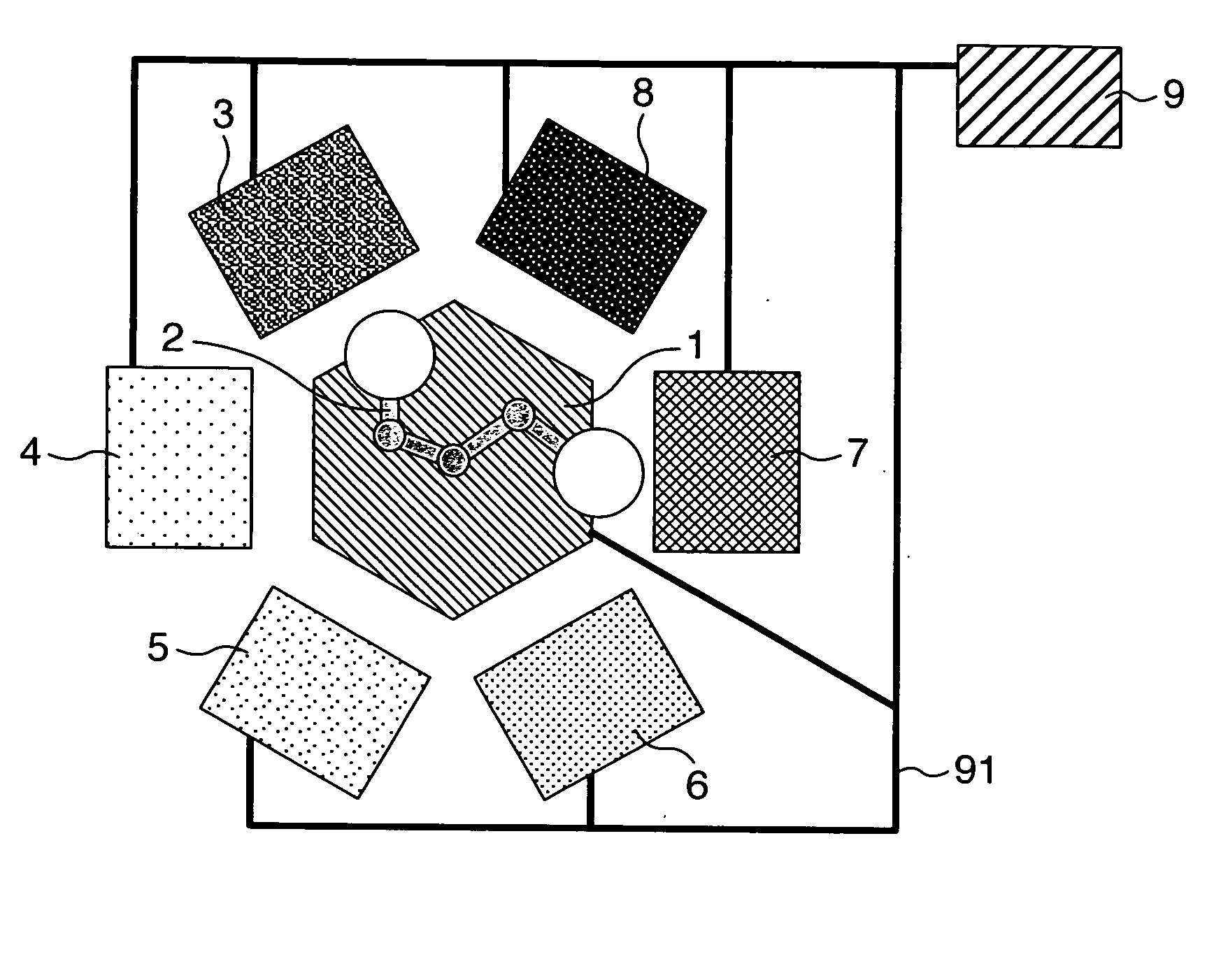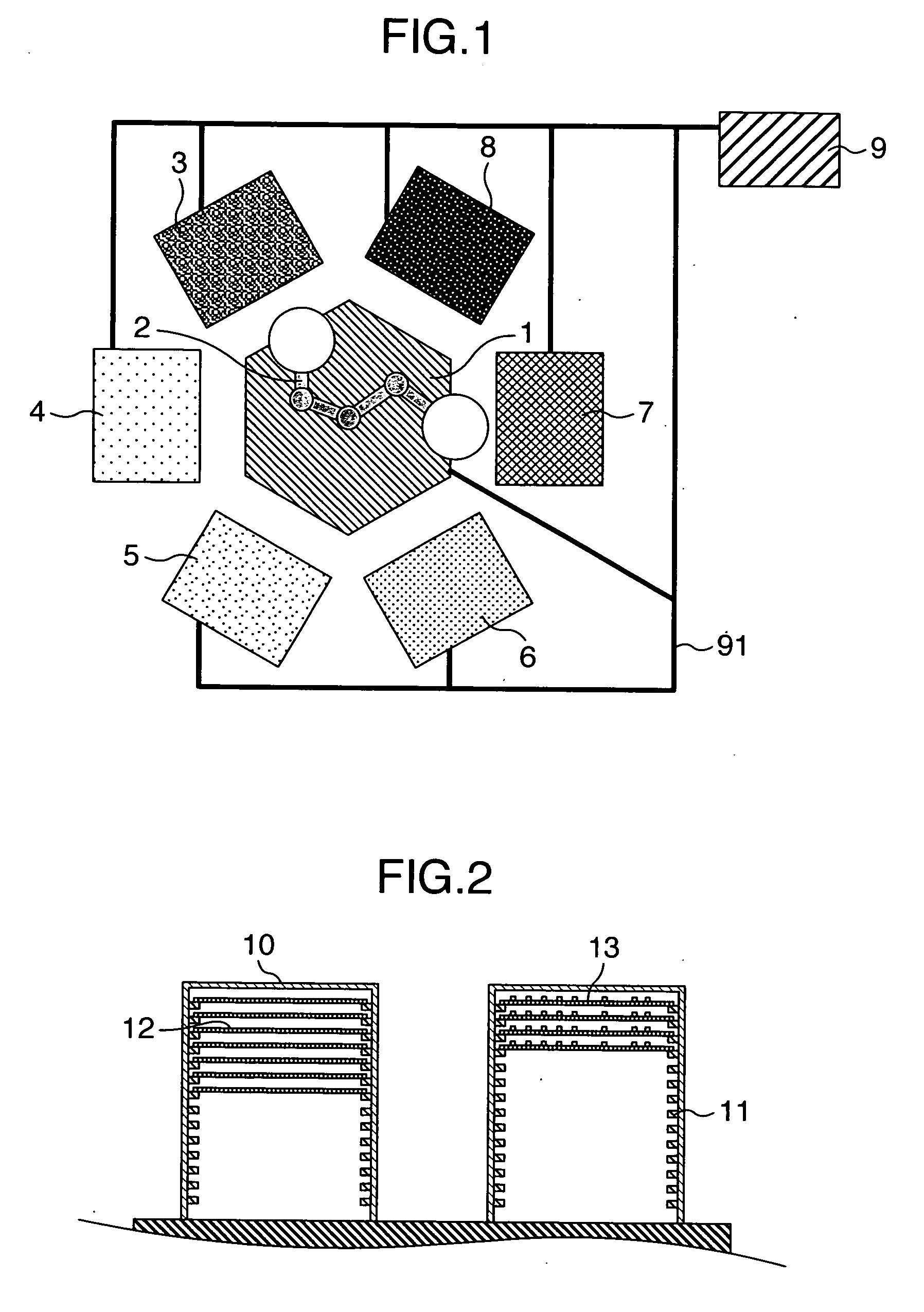Imprinting machine and imprinting method
a printing machine and imprinting technology, applied in the field of printing machines and imprinting methods, can solve the problems of lithography technique getting close to a limit, affecting the processing speed of substrates, and requiring a lot of time for forming patterns, so as to prevent the breakage of substrates and molds, and reduce the speed of substrate processing
- Summary
- Abstract
- Description
- Claims
- Application Information
AI Technical Summary
Benefits of technology
Problems solved by technology
Method used
Image
Examples
embodiment 1
[0096]FIG. 1 shows a schematic plan view of an arrangement of the respective units of the imprinting apparatus in accordance with the present invention. The following micro pattern imprinting experiments are executed by using the imprinting apparatus in accordance with the present embodiment.
[0097] The present imprinting apparatus is constituted by a substrate carrying in and carrying out unit 3, a mold storing unit 4, an alignment unit 5, a pressurizing unit 6, a peeling unit 7 and a mold cleaning unit 8, which are arranged around a conveying unit 1. Further, the respective units are connected to a control unit 9 by a connecting cable 91. In the substrate carrying in and carrying out unit 3, there are set a plurality of substrates (not shown) in which a polystyrene resin membrane having a thickness of 500 nm is formed on a silicone wafer having a diameter of 6 inch φ. The substrate is moved to each of the units in accordance with each of the steps by a robot arm 2.
[0098] A descri...
embodiment 2
[0120] The same imprinting experiment as the embodiment 1 is executed by an imprinting apparatus using a photo cure type pressurizing unit shown in FIG. 9. In this case, the substrate employs a substrate obtained by applying PKA01 (produced by TOYO GOSEI) corresponding to a liquid photo cure type resin onto the silicone wafer having a diameter of 6 inchφ in accordance with a spin coat method.
[0121] A quartz mold 64 and a substrate 65 which are aligned by the alignment unit are moved to the stage side adapter 28 so as to be adsorbed. Next, an entire stage is moved upward by the stage elevating drive motor until the quartz mold 64 is in contact with a mold fixing jig 62 fixed to the frame 35 so as to pressurize and closely attach the substrate 65 and the quartz mold 64.
[0122] Next, an ultraviolet ray having a power of 1000 mJ / cm2 is irradiated by an ultraviolet ray lamp 61 on which an extra-high pressure mercury lamp is mounted. Next, the stage is moved downward, the sample in which...
embodiment 3
[0124] The same imprinting experiment as the embodiment 1 is executed by using an imprinting apparatus in which a mold inspecting unit 95 and a substrate inspecting unit 96 are added to the imprinting apparatus in accordance with the embodiment 1 shown in FIG. 10. In FIGS. 10 and 11, the same reference numerals as those in FIGS. 1 and 8 denote the same elements. FIG. 11 shows a flow chart paying attention to the movement of the metal mold substrate 92 and the mold 93 at that time. The present flow chart is described for explanation in such a manner that only one set of substrate and mold are moved, however, plural sets of substrates / molds are actually moved and processed simultaneously.
[0125] First, the substrate 92 in which the resin membrane is formed is moved from the substrate carrying in and carrying out unit 3 to the alignment unit 5 by the conveying robot arm 2 (FIG. 11A→FIG. 11B).
[0126] Next, the mold 93 is moved from the mold storing unit 4 to the alignment unit 5 by the ...
PUM
| Property | Measurement | Unit |
|---|---|---|
| size | aaaaa | aaaaa |
| thickness | aaaaa | aaaaa |
| thickness | aaaaa | aaaaa |
Abstract
Description
Claims
Application Information
 Login to View More
Login to View More - R&D
- Intellectual Property
- Life Sciences
- Materials
- Tech Scout
- Unparalleled Data Quality
- Higher Quality Content
- 60% Fewer Hallucinations
Browse by: Latest US Patents, China's latest patents, Technical Efficacy Thesaurus, Application Domain, Technology Topic, Popular Technical Reports.
© 2025 PatSnap. All rights reserved.Legal|Privacy policy|Modern Slavery Act Transparency Statement|Sitemap|About US| Contact US: help@patsnap.com



